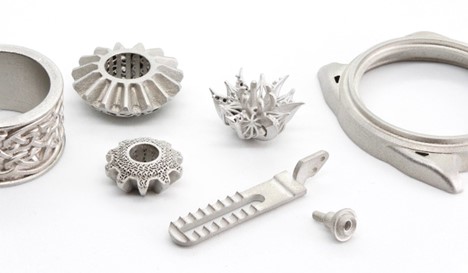
Prototyping is the genesis of and remains the strongest application for 3D printing. Going beyond, though, into final part production – particularly at scale – offers a full end-to-end workflow that more currently describes the goals for additive manufacturing.
Tuning that to the metal side of industry, the need to prototype, finalize, and scale into production for orders from one to one million parts is a major and growing focus. Sinter-based metal 3D printing is uniquely positioned to address these needs – and, in Holo’s case, is capable of doing so with incredible precision.
Sinter-Based Metal 3D Printing

[Fine-featured parts made with Holo’s PureForm technology / Image Source: Holo]
These additive manufacturing (AM) processes include PureForm™ (Holo), binder jetting (like from Desktop Metal), Metal Jet (HP), and other bound metal printing (BMP) technologies. While each of these processes has its differentiating qualities and “secret sauce” to additively manufacture final metal parts, they have in common some essential qualities.
A unique approach to 3D printing in the front end of the process binds metal together. In the back end of each process, debinding and sintering stages are virtually identical to those used in MIM.
Precise Metal 3D Printing
As anyone familiar with AM well understands by now, 3D printing enables a certain freedom of complexity. Geometries previously impossible or requiring assembly can now be made in one part, in one print. Taking that capability to metal and scaling it both down (in terms of part and feature size) and up (in terms of volume production) is the major appeal for metal 3D printing as an industry solution.
When it comes to the mass production of complex, precise metal parts, turning to MIM without the mold opens up a new realm of possibilities.
Quality

[Fine-featured, high-resolution prints like this threaded part enabled by PureForm technology / Image Source: Holo]
In order to attain the quality required for highly complex parts, the team at Holo stepped back to reexamine existing solutions and market needs. Approaching parts like spring arms for eyeglasses, grippers for a laparoscopic surgical tool, or, as seen above, finely threaded custom medical screws took some rethinking.
The PureForm approach utilizes a proprietary slurry of MIM powder and photoresistive polymer binder with high-resolution, high-throughput optical imagers. Understanding how to suit HD lithography printers to metal materials requires a lower metal loading due to issues of optical penetration. What could have been a bug in that lower metal loading, due to higher amounts of shrinkage, our engineers developed into a feature; resolution is improved because PureForm’s shrinkage is isotropic and predictable.
Predictability in final part dimension is vital, especially for the exacting industries we’re enabling, that require these finely detailed parts.
PureForm printing enables accuracy at typically 25µm (or 0.1% on a dimension), with a surface roughness of 1-3µm Ra, typically not requiring any finishing. That quality hits industry standard specs including MIF35 material properties.
Scalability
Another often-touted benefit of 3D printing on the whole is the capability of ramping up from prototype to production. Doing so at mass production scale has been a sticking point for wider adoption, but sinter-based metal 3D printing is uniquely poised to address volumes.
PureForm, for example, can hit cost points – at volume – that are lower than traditional manufacturing approaches like MIM or machining.
For certain geometries, this is also true compared to MIM at any volume. The removal of tool costs and requisite lead times also drastically slashes time and cost to production.
Especially working in a photopolymer process that can scale up, we like to say PureForm enables production of parts From One to One Million.
Ease of Deployment
MIM is familiar; that’s a given. Bringing PureForm™ into a MIM-familiar facility or production workflow is a smooth process, removing barriers to adoption along the way.
The end stages, including sintering, of sinter-based metal 3D printing already utilize MIM equipment like furnaces. Materials are also familiar – and, in the case of PureForm’s approach, are safe to handle, not requiring additional capital investment into powder handling equipment. The slurry approach removes barriers of safe handling or inert environments seen in many other metal AM approaches, again easing the deployment of a new production process.
The robustness of green parts also minimizes part breakage along the way, ensuring that volumes stay where they should be. With little-to-no secondary processing after sintering, PureForm also minimizes capital investment and operational costs related to fine finishing work.
Real-World Proven

[Customer parts are ready to go and already in their hands – and processes / Image Source: Holo]
We can’t speak to other technologies’ successes, but well over 10,000 PureForm parts have been shipped to customers in the medical, aerospace and defense, consumer, and semiconductor industries.
We’ve offered PureForm as a service as a vertically integrated supplier for some time now, and in 2023 introduced our H200 printer for direct sale as well for customers who want to produce their own parts in-house.
AMS 2024
I am looking forward to discussing these and many other aspects of Sinter-Based Metal AM at AMS 2024 alongside Ric Fulop, Co-Founder & CEO, Desktop Metal; and Ramon Pastor, Vice President and General Manager, Large Format Printing Business, HP.
Join us at AMS on day one, February 6, at 11:20am in Session 1: The Evolution of Series Production: Metals and Polymers, for Panel 3: Sinter Based AM, with moderator: Amy Elliott, Senior Scientist, Group Leader, Robotics and Intelligent Systems, Oak Ridge National Laboratory.
Subscribe to Our Email Newsletter
Stay up-to-date on all the latest news from the 3D printing industry and receive information and offers from third party vendors.
You May Also Like
3D Printing Webinar and Event Roundup: April 28, 2024
In this week’s 3D Printing Webinar and Event Roundup, the Ceramics Expo is taking place in Michigan, Stratasys continues its advanced training courses, and SPE is holding a Polymer Characterization...
3DPOD Episode 196: Bioprinting and Biofabrication with Dietmar Hutmacher, Queensland University of Technology
Dietmar Hutmacher is a Professor and Chair in Regenerative Medicine at the Faculty of Engineering, School of Mechanical, Medical, and Process Engineering at Queensland University of Technology. He possesses extensive...
3DPOD Episode 195: 3D Printing Wood, Coffee, and Seaweed with Andy Jeffery, Marvel Labs
Andy Jeffery is a long-time 3D printing veteran who has repeatedly introduced binder jetting technologies to new areas. Starting as one of the earliest adopters of this technology for filters,...
3DPOD Episode 194: Product Design and the Additive Journey with PADT Hardware Director David Dietrich
David Dietrich‘s journey in 3D printing spans from materials engineering roles at Boeing and ORNL to his position as an engineering fellow at Honeywell, showcasing his extensive experience in metals...






























